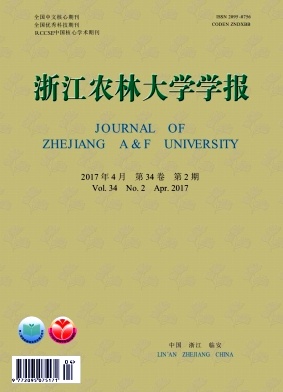-
团粒结构及其稳定性是土壤质量的敏感性物理指标[1],能决定土壤物理性质和调节土壤肥力,影响土壤通透性、孔隙性和持水性[2]。良好的团粒结构能起到协调养分的消耗和积累、稳定土壤温度、改善土壤肥力和利于植物根系伸展的作用[3]。改良土壤有多种方式,林下养鸡Gallus domesticus是其中一种新兴的培肥改土方式。林下养鸡会增加鸡粪含量,鸡粪是优质的有机肥料[4],鸡粪中含有丰富的有机物质、氮、磷、钾和其他植物必需养分,能提高土壤养分含量[5]和促进培肥改土,兼顾良好的经济效益和社会效益,具有改良土壤、节省林地肥料、灭虫锄草和促进树木生长等优点[6-8],且有机肥有利于增加土壤团聚体含量、提高土壤团聚体稳定性和改善土壤结构[9-10]。土壤是具有分形特征的系统,土壤团粒结构可以用分形维数来描述[11]。TURCOTTE[11]提出多孔介质材料的粒径分布与分形维数的关系公式;杨培岭等[12]提出了用粒径的质量分布取代粒径的数量分布来描述土壤分形特征,此法具有精确简便的优点,应用更为广泛。分形维数可以客观反映土壤粒径大小[13]、结构性状[14]和理化性质[15-16],并能够定量化描述土壤肥力状况[17]。目前,有关林下养鸡的研究主要集中在养鸡密度管理和养鸡对土壤理化性质等的影响方面,而有关林下养鸡对土壤分形特征影响方面的研究尚未见报道。本研究通过在四川盆周低山丘陵区柑橘林下养鸡,研究不同养鸡密度对土壤团粒结构分形特征、理化性质和微生物数量及土壤酶活性的影响,探讨分形维数与土壤理化性质、微生物数量及土壤酶活性的关系,为构建林下养鸡复合经营模式和了解林下养鸡对林地土壤肥力的影响提供参考。
HTML
-
试验地位于四川省丹棱县红石村退耕还林示范区(30°03′N,103°29′E),海拔为495~583 m。该区地处于四川盆地西南边缘,属于亚热带湿润季风气候,地带性植被为亚热带常绿阔叶林。根据丹棱县气象站(海拔496.2 m)的历年气象观测资料统计,全年日平均气温为16.6 ℃,最热月均温25.6 ℃,最冷月均温6.3 ℃,全年降水量为1 232.8 mm,年降水天数为170.2 d,降水集中于5-8月,年蒸发量为1 002.6 mm。2007年9月上旬开始在柑橘Citrus reticulate林下设置不同的养鸡密度(0,600,1 200和2 400只·hm-2)进行长期养鸡试验,研究养鸡对土壤理化性质的影响。柑橘林下鸡的放养时间是每年的9月上旬至第2年的4月中下旬,5-8月林下不养鸡。
-
试验地柑橘园建于2000年,株行距为3 m × 4 m,土壤为黄壤。在调查柑橘园试验区的基础上,根据典型性、代表性的原则,分别在坡向、坡度、坡位和海拔高度基本一致的柑橘园中设置不同养鸡密度处理(0,600,1 200和2 400只·hm-2,以下分别以ck, T600,T1200和T2400表示)。设置3次重复·处理-1,共12个小区,各小区面积为20 m × 20 m。各小区用丝网隔离,鸡群在限定的养殖区活动,以保证其密度。选择大小基本一致的脱温雏鸡进行放养;放养期间鸡苗如意外死亡,应及时清理后补充与该群体平均质量相当的健康鸡苗,保证小区鸡密度恒定。各试验小区柑橘及鸡苗的管理均按常规进行,鸡饲料的投放量按鸡数量等比例增加。于2012年8月上旬在每个标准地内采用蛇形5点取样法分别采集0~20 cm土层混合样品,带回实验室后分成2份,一份鲜样用于测定微生物数量,另一份风干后用于测定土壤团聚体、有机质、碱解氮、有效磷、速效钾、蔗糖酶、脲酶和磷酸酶。同时用环刀采集0~20 cm土层原状土壤样品以测定土壤容重和孔隙度。
-
土壤团聚体组成采用机械筛分法;土壤有机质用重铬酸钾氧化-外加热法测定;土壤全氮采用半微量凯氏法;碱解氮采用碱解-扩散法;有效磷采用双酸浸提法;速效钾采用乙酸铵浸提-火焰光度法[18];微生物数量采用平板法测定[19],酶活性采用比色法测定[20];土壤团聚体分形维数采用杨培岭法计算,分形维数的计算过程与方法如下[12, 21]:
具有自相似结构的多孔介质——土壤,由大于某一粒径di(di>di+1,i=1,2,…)的土粒构成的体积V(δ>di)可由类似Katz的公式表示:
式(1)中:δ是码尺;A,k是描述形状、尺度的常数。
通常粒径分析资料是由一定粒径间隔的颗粒质量分布表示的,以di表示两筛分粒级di与di+1间粒径的平均值,忽略各粒级间土粒比重ρ的差异,即ρi=ρ(i=1,2,…),则:
式(2)中:W(δ>di)为大于di的累积土粒质量。以W0表示土壤各粒级质量的总和,由定义有$ \mathop {\lim }\limits_{i = \infty } {d_i} = 0$,则由式(2)得:
由式(2)和式(3)导出:
设dmax为最大粒级土粒的平均直径,W(δ>dmax),代入(4)式有k=dmax。由此得出土壤颗粒的质量分布与平均粒径间的分形关系式:
对上式两边取对数,即得:
分别以lg(Wi/W0),lg(di /dmax)为纵、横坐标,不难看出3-D是lg(di/dmax)和lg(Wi/W0)的实验直线的斜率,因此,要测定D即可用回归分析方法。
-
采用SPSS 19.0软件对文中数据进行统计分析,表中数据均为平均值±标准差,采用单因子方差分析(ANOVA)和邓肯法(SSR)检验不同模式土壤各变量之间的显著性差异。
1.1. 试验区自然概况
1.2. 研究方法
1.2.1. 样地调查和样本采集
1.2.2. 测定方法
1.2.3. 数据处理与计算
-
由表 1可知:各处理土壤分形维数(干筛和湿筛)、土壤结构体破坏率和不稳定团粒指数均呈现出ck>T600>T1200>T2400变化规律,其中各处理间的分形维数(干筛和湿筛)差异显著,T1200与T600,T600与ck间的土壤结构体破坏率差异不显著,各处理间的不稳定团粒指数差异显著;>0.25 mm粒级团聚体(干筛和湿筛)均呈现出ck<T600<T1200<T2400的变化规律,且各处理间差异显著。回归分析发现,干筛条件下团聚体分形维数与>5.00 mm,5.00~2.00 mm,2.00~1.00 mm,1.00~0.50 mm和>0.25 mm粒级团聚体质量分数呈显著负相关(P<0.05),与0.50~0.25 mm粒级团聚体质量分数、结构体破坏率和不稳定团粒指数呈显著正相关(P<0.05);湿筛条件下,土壤团聚体分形维数与>5.00 mm,5.00~2.00 mm,1.00~0.50 mm和>0.25 mm粒级团聚体质量分数呈显著负相关(P<0.05),与2.00~1.00 mm,0.50~0.25 mm粒级团聚体质量分数、结构体破坏率和不稳定团粒指数呈显著正相关(P<0.05)。因此,林下养鸡增加土壤团聚体及水稳性团聚体质量分数,降低土壤结构体破坏率和提高土壤结构体稳定性。土壤团粒结构分形维数可以表征林下养鸡对各粒级团聚体质量分数状况及土壤结构与稳定性的影响。
处理 不同粒径团聚体质量分数/(g·kg-1) 结构体破坏率/% 不稳定团粒指数/% 分形维数 相关系数 >5.00 5.00~2.00 2.00~1.00 1.00~0.50 mm T2400 Ⅰ 275.9±18.5 a 327.7±18.7 a 182.5±15.9 b 116.4±11.2 d 59.3±4.3 d 12.6±1.7 c 21.1±1.4 d 2.174±0.028 d 0.9991±0.004** Ⅱ 104.2±9.9 a 206.3±11.7 a 170.2±12.1 a 168.0±7.5 a 139.8±5.8 a 2.609±0.019 d 0.984±0.002** T1200 Ⅰ 239.6±18.1 b 299.8±17.4 ab 191.6±10.5 ab 140.5±12.0 c 79.0±4.4 c 16.4±2.2 b 27.1±2.0 c 2.248±0.014 c 0.987±0.004** Ⅱ 65.6±9.2 b 124.9±11.9 b 141.1±11.3 b 205.7±17.0 b 191.5±6.3 b 2.680±0.018 c 0.958±0.004** T600 Ⅰ 195.1±17.0 c 276.4±25.9 bc 202.5±4.2 ab 161.4±6.3 b 98.1±7.9 b 18.7±0.5 ab 32.1±1.7 b 2.321±0.031 b 0.983±0.001** Ⅱ 49.7±6.7 c 75.4±7.5 c 119.7±5.2 c 222.3±19.2 b 212.2±17.7 ab 2.725±0.011 b 0.938±0.003** ck Ⅰ 153.0±12.1 d 248.5±5.4 c 213.1±16.0 a 182.0±7.9 a 119.8±8.0 a 20.5±1.2 a 36.7±1.8 a 2.381±0.025 a 0.976±0.004** Ⅱ 22.2±3.3 d 47.1±5.0 d 74.8±5.4 d 259.9±23.2 a 229.2±18.0 a 2.760±0.013 a 0.907±0.008** 说明:Ⅰ为干筛条件; Ⅱ为湿筛条件。同一列数据后不同字母表示差异显著 (P<0.05) Table 1. Effects of different raising chicken treatments on soil aggregate composition and fractal dimension
-
与ck相比(表 2),T600,T1200和T2400处理土壤容重分别降低2.6%,9.7%和12.0%,各处理除T600外均与ck差异显著,T1200与T2400处理间差异无显著;非毛管孔隙仅T2400处理显著高于ck,但两者与其余处理差异不显著;毛管孔隙各处理间差异无显著;总孔隙仅T2400处理显著高于ck处理,其他处理与ck差异不显著,T1200与T2400处理差异不显著。对土壤物理性质与土壤团粒结构分形维数回归分析结果表明(表 3):土壤团粒结构分形维数(干筛和湿筛)与土壤容重、非毛管孔隙、毛管孔隙和总孔隙间呈显著或极显著相关。说明林下养鸡对提高土壤物理性质具有较好的作用;团粒结构分形维数越低,土壤物理性质越好。因此,土壤团粒结构分形维数的高低能够表征柑橘林下养鸡对土壤物理性质的影响。
处理 容重/(g·cm-3) 非毛管孔隙/% 毛管孔隙/% 总孔隙/% 有机质/(g·kg-1) 碱解氮/(mg·kg-1) 有效磷/(mg·kg-1) 速效钾/(mg·kg-1) T2400 1.165±0.039 b 14.1±0.7 a 36.2±1.3 a 50.3±0.9 a 27.0±0.7 a 130.4±8.8 a 108.2±12.6 a 177.3±11.8 a T1200 1.196±0.047 b 13.0±1.0 ab 35.9±0.7 a 48.9±1.6 ab 23.4±0.6 b 105.3±6.4 b 79.0±7.3 b 129.4±14.4 b T600 1.289±0.045 a 12.6±0.9 ab 35.2±1.0 a 47.8±1.1 b 20.5±0.6 c 90.5±6.6 c 58.3±6.0 c 90.5±7.2 c ck 1.324±0.036 a 12.2±0.8 b 34.8±1.4 a 47.0±0.9 b 16.2±0.8 d 62.1±4.4 d 3.6±0.5 d 39.2±3.5 d 说明:同一列数据后不同字母表示差异显著 (P<0.05)。 Table 2. Effects of different raising chicken treatments on soil physical and chemical properties
项目 拟合回归方程相关系数 相关系数 干筛条件 湿筛条件 干筛条件 湿筛条件 容重 D=1.036 3+1.001 1x D=1.850 2+0.678 0x 0.914** 0.861** 非毛管孔隙 D=3.122 4-0.064 9x D=3.256 2-0.043 5x -0.779** -0.725** 毛管孔隙 D=3.230 0-0.026 7x D=3.454 7-0.021 4x -0.646* -0.599* 总孔隙 D=4.101 7-0.037 5x D=3.994 4-0.026 8x -0.730** -0.726** 有机质 D=2.707 9-0.019 6x D=2.991 5-0.013 7x -0.972** -0.944** 碱解氮 D=2.577 1-0.003 1x D=2.898 1-0.002 1x -0.961** -0.925** 有效磷 D=2.402 5-0.002 0x D=2.777 9-0.001 4x -0.941** -0.913** 速效钾 D=2.444 0-0.001 5x D=2.809 8-0.001 1x -0.954** -0.950** 说明:*表示在0.05水平上相关,**表示在0.01水平上相关。 Table 3. Relationship between fractal dimension and soil physical and chemical properties
各处理间土壤有机质、碱解氮、有效磷和速效钾质量分数差异显著(表 2)。与ck相比,T600,T1200和T2400处理有机质质量分数分别增加26.5%,44.4%和66.7%;碱解氮分别增加45.7%,69.6%和110.0%;有效磷分别增加15.2倍、20.9倍和29.1倍;速效钾分别增加1.3倍、2.3倍和3.5倍。对土壤养分与土壤团粒结构分形维数回归分析结果表明(表 3):干筛和湿筛得到的土壤团粒结构分形维数与土壤有机质、碱解氮、有效磷和速效钾均呈极显著负相关。说明柑橘林下养鸡条件下土壤团粒结构分形维数越高,土壤养分含量越低。因此,土壤团粒结构分形维数的高低能够表征土壤养分状况。
-
由表 4可知:各处理间细菌、真菌、放线菌和总微生物数量、蔗糖酶、脲酶和磷酸酶活性差异显著。与ck相比,T600,T1200和T2400处理细菌数量分别增加73.3%,177.5%和221.9%;真菌数量分别增加46.2%,75.7%和213.8%;放线菌数量分别增加57.6%,81.8%和133.2%;总微生物数量分别增加72.9%,175.6%和220.2%;蔗糖酶活性分别增加22.4%,35.2%和75.4%;脲酶活性分别增加70.2%,104.5%和179.2%;磷酸酶活性分别增加178.1%,207.0%和400.4%。对土壤微生物数量及酶活性与土壤团粒结构分形维数回归分析结果表明(表 5),土壤团粒结构分形维数(干筛和湿筛)与细菌、真菌、放线菌和总微生物数量、蔗糖酶、脲酶和磷酸酶活性均呈极显著负相关。因此,林下养鸡有利于提高土壤的生物活性,且土壤团粒结构分形维数能够表征土壤微生物数量和土壤酶活性的状况。
处理 微生物数量/(菌落形成单位·g-1) 蔗糖酶/(mg·g-1·d-1) 脲酶/(mg·g-1·d-1) 磷酸酶/(mg·g-1·d-1) 细菌 (×107) 真菌 (×103) 放线菌 (×105) 总微生物 (×107) T2400 10.59±0.51a 7.75±0.43 a 16.79±0.91a 10.76±0.52 a 11.77±0.54 a 0.497±0.021a 1.211±0.099 a T1200 9.13±0.40 b 4.34±0.37 b 13.09±0.72 b 9.26±0.39 b 9.07±0.25 b 0.364±0.034 b 0.743±0.055 b T600 5.70±0.56 c 3.61±0.24 c 11.35±0.48 c 5.81±0.57 c 8.21±0.37 c 0.303±0.026 c 0.673±0.066 b ck 3.29±0.30d 2.47±0.16d 7.20±0.62d 3.36±0.29d 6.71±0.57 d 0.178±0.020 d 0.242±0.030 c 说明:同一列数据后不同字母表示差异显著 (P<0.05)。 Table 4. Effects of different raising chicken treatments on soil microbial population and enzyme activities
项目 拟合回归方程 相关系数 干筛条件 湿筛条件 干筛条件 湿筛条件 细菌 D=2.471 3-0.026 5x D=2.828 4-0.018 9x -0.952** -0.941** 真菌 D=2.451 8-0.037 6x D=2.818 4-0.027 6x -0.928** -0.946** 放线菌 D=2.546 2-0.021 9x D=2.879 8-0.015 4x -0.952** -0.932** 总微生物 D=2.472 4-0.026 2x D=2.829 2-0.018 6x -0.953** -0.942** 蔗糖酶 D=2.639 5-0.040 1x D=2.958 1-0.029 6x -0.935** -0.961** 脲酶 D=2.502 6-0.660 6x D=2.853 7-0.478 5x -0.958** -0.965** 磷酸酶 D=2.438 2-0.219 3x D=2.806 9-0.158 6x -0.948** -0.954** 说明:**表示在0.01水平上相关。 Table 5. Relationship between fractal dimension and microbial population or enzyme activities
2.1. 土壤团粒结构分形维数
2.2. 分形维数与土壤理化性质的关系
2.3. 分形维数与土壤微生物和酶的关系
-
土壤团聚体组成、稳定性和孔隙状况对土壤肥力及结构稳定性有重要影响[3]。团聚体是土壤有机质的主要固存场所[22-23],有机质是形成土壤团聚体主要的黏结剂[24-25]。本研究发现:柑橘林下养鸡后有机质含量增加,>0.25 mm粒级团聚体(干筛和湿筛)质量分数也增加。林下养鸡和鸡粪还林增加土壤有机物质输入,使林地土壤有机胶体增加,土壤颗粒间胶结作用加强,土壤中大粒级团聚体增加和稳定性增强[26]。周萍等[27]研究发现:>0.25 mm粒级团聚体越少,其分形维数越高,反之,则越低;何东进等[28]对毛竹Phyllostachys edulis-杉木Cunninghania lanceolata混交林土壤团粒结构分形特征的研究结果表明,土壤团粒结构分形维数与>0.25 mm和>5.00 mm粒级土壤水稳定性团聚体含量之间呈显著负相关。本研究发现:团聚体和水稳定性团聚体质量分数越高,分形维数越低,这与何东进等[28]的研究结果相同。李阳兵等[29]研究发现:土壤团聚体分形维数与其结构及稳定性关系密切,团粒结构粒径分布的分形维数越小,则土壤结构与稳定性越好。本研究发现,分形维数与土壤结构体破坏率和不稳定指数呈显著性正相关,团粒结构分形维数对结构体破坏率和不稳定指数具有较好的表征作用,进一步说明土壤团粒结构分形维数与土壤结构及其稳定性关系密切。这与其他学者[29-31]的研究结果相同,即>0.25 mm团聚体质量分数越高,分形维数越低,土壤孔性越好,结构越稳定,肥力越高。因此,土壤团粒结构的分形维数可以作为表征土壤结构和性质的重要参数,也可以作为表征土壤稳定性的指标,是理想的土壤肥力评价指标[3, 21]。
土壤孔隙状况直接影响土壤通气性、透水性及根系穿插的难易程度,对土壤中水、肥、气、热和生物活性等具有重要的调节作用[32]。柑橘林下养鸡后土壤容重降低,而>0.25 mm粒级的团聚体质量分数(干筛和湿筛)、其他理化性质(容重除外)、微生物数量和酶活性均增加;且随养鸡密度的增加,土壤物理性质、化学性质及生化特性的影响作用加强,并以2 400只·hm-2处理对土壤的改良效果最好。土壤容重的降低与孔隙度的提高主要是由于柑橘林下养鸡后,鸡粪产量增多(即有机肥施入增多),土壤变肥沃,促进植物良好生长,植物根系尤其是细根对土壤的穿插作用增强,从而使土壤相对疏松多孔,容重变小;同时,土壤中有机质提高,有利于增加土壤中大粒级团聚体的形成与稳定,且为土壤动物活动提供了相对更多的能源物质,使土壤动物活动更为频繁,对土壤的疏松起到了更好的促进作用[33-34],所以柑橘林下养鸡对改善土壤物理性质具有较好的促进作用。鸡粪中含有丰富的有机物质及氮、磷、钾等养分,在鸡群粪尿排泄物施入土壤后,这些养分直接增加了土壤养分含量和肥力。另外,鸡粪有机肥输入林地土壤后为微生物活动提供了碳源、养分和丰富的酶促基质,促进土壤微生物的生长和繁殖,进而改善土壤理化性质和提高酶活性[35]。本研究结果发现,土壤团粒结构分形维数与土壤容重、非毛管孔隙、毛管孔隙、总孔隙、有机质、碱解氮、有效磷、速效钾、细菌、真菌、放线菌、总微生物、蔗糖酶、脲酶和磷酸酶活性呈显著或极显著相关。因此,土壤团粒结构分形维数能够较好的评价林下养鸡后土壤理化性质变化、微生物数量和土壤酶活性状况,是评价土壤肥力的一个综合性指标[29]。
-
柑橘林下养鸡能增加>0.25 mm粒级土壤团聚体和水稳性团聚体质量分数及稳定性,降低团粒结构分形维数,且在0~2 400只·hm-2密度范围内,养鸡密度高,分形维数低。柑橘林下养鸡能改良土壤结构和提升土壤肥力,且在一定密度范围内(0~2 400只·hm-2)土壤肥力随养鸡密度的增加而增加。无论湿筛还是干筛条件下,土壤分形维数与>0.25 mm和>5.00 mm粒级团聚体质量分数呈显著相关。土壤团粒结构分形维数与土壤理化性质、微生物数量及酶活性均呈显著相关,可以作为柑橘林下养鸡处理后土壤肥力变化的综合性评价指标。






 DownLoad:
DownLoad: